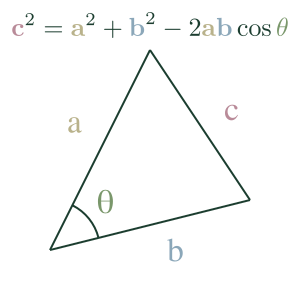Law Of Cosines

The Law of Cosines expresses the relationship between the length of a triangle's sides and one of its angles. For the cover triangle, the expression is:
We can use it to find the length of one side of a triangle if we know the opposite angle and length of the other sides.
We can also use it to find the angle, given the length of the triangle's sides.
or
An interesting note is that , so when you have a right triangle, we can simplify the expression to:
...which is the Pythagorean Theorem.
Maths/Trigonometry
See also Law of Sines.